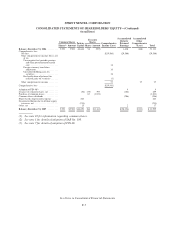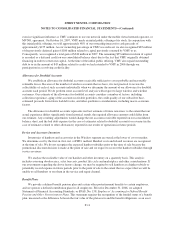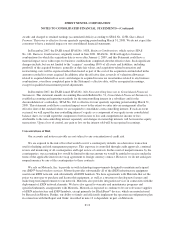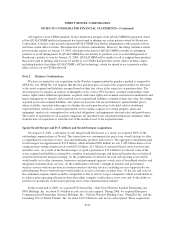Sprint - Nextel 2007 Annual Report Download - page 96
Download and view the complete annual report
Please find page 96 of the 2007 Sprint - Nextel annual report below. You can navigate through the pages in the report by either clicking on the pages listed below, or by using the keyword search tool below to find specific information within the annual report.SPRINT NEXTEL CORPORATION
NOTES TO CONSOLIDATED FINANCIAL STATEMENTS—(Continued)
exercise significant influence as VMU continues to use our network under the mobile virtual network operator, or
MVNO, agreement. On October 16, 2007, VMU made an initial public offering of its stock. In conjunction with
this initial public offering, we sold approximately 48% of our ownership interest for cash proceeds of
approximately $155 million. As our ownership percentage in VMU was reduced, we also recognized $85 million
of the previously deferred gain of $180 million related to capital previously returned by VMU to us.
Consequently, we recognized a total gain of $240 million in 2007. The remaining $95 million in return of capital
is recorded as a deferred credit on our consolidated balance sheet due to the fact that VMU originally obtained
financing in order to return our capital. At the time of the initial public offering, VMU also repaid outstanding
debt to us in the amount of $45 million related to credit we had extended to VMU in 2006 through our
participation in a revolving credit facility.
Allowance for Doubtful Accounts
We establish an allowance for doubtful accounts receivable sufficient to cover probable and reasonably
estimable losses. Because of the number of wireless accounts that we have, it is not practical to review the
collectibility of each of such accounts individually when we determine the amount of our allowance for doubtful
accounts each period. We do perform some account level analysis with respect to large wireless and wireline
customers. Our estimate of the allowance for doubtful accounts considers a number of factors, including
collection experience, aging of the accounts receivable portfolios, the credit quality of our subscriber base,
estimated proceeds from future bad debt sales, and other qualitative considerations, including macro-economic
factors.
The allowance for doubtful accounts represents our best estimate of future outcomes; to the extent that our
actual experience differs significantly from historical trends, the required allowance amount could differ from
our estimate. Any resulting adjustments would change the net accounts receivable reported on our consolidated
balance sheet, and the bad debt expense (in the case of estimates related to doubtful accounts) or revenue (in the
case of estimates related to other allowances) reported in our results of operations in future periods.
Device and Accessory Inventory
Inventories of handsets and accessories in the Wireless segment are stated at the lower of cost or market.
We determine cost by the first-in, first-out, or FIFO, method. Handset costs and related revenues are recognized
at the time of sale. We do not recognize the expected handset subsidies prior to the time of sale because the
promotional discount decision is made at the point of sale and we expect to recover the handset subsidies through
service revenues.
We analyze the realizable value of our handset and other inventory on a quarterly basis. This analysis
includes assessing obsolescence, sales forecasts, product life cycle and marketplace and other considerations. If
our assessments regarding the above factors change, we may be required to sell handsets at a higher subsidy or
potentially record expense in future periods prior to the point of sale to the extent that we expect that we will be
unable to sell handsets or use them in the service and repair channel.
Benefit Plans
We provide a defined benefit pension plan and certain other postretirement benefits to certain employees,
and we sponsor a defined contribution plan for all employees. Effective December 31, 2006, we adopted
Statement of Financial Accounting Standards, or SFAS, No. 158, Employers’ Accounting for Defined Benefit
Pension and Other Postretirement Plans. This statement requires the recognition of the funded status of a benefit
plan, measured as the difference between the fair value of the plan assets and the benefit obligations, as an asset
F-11
























